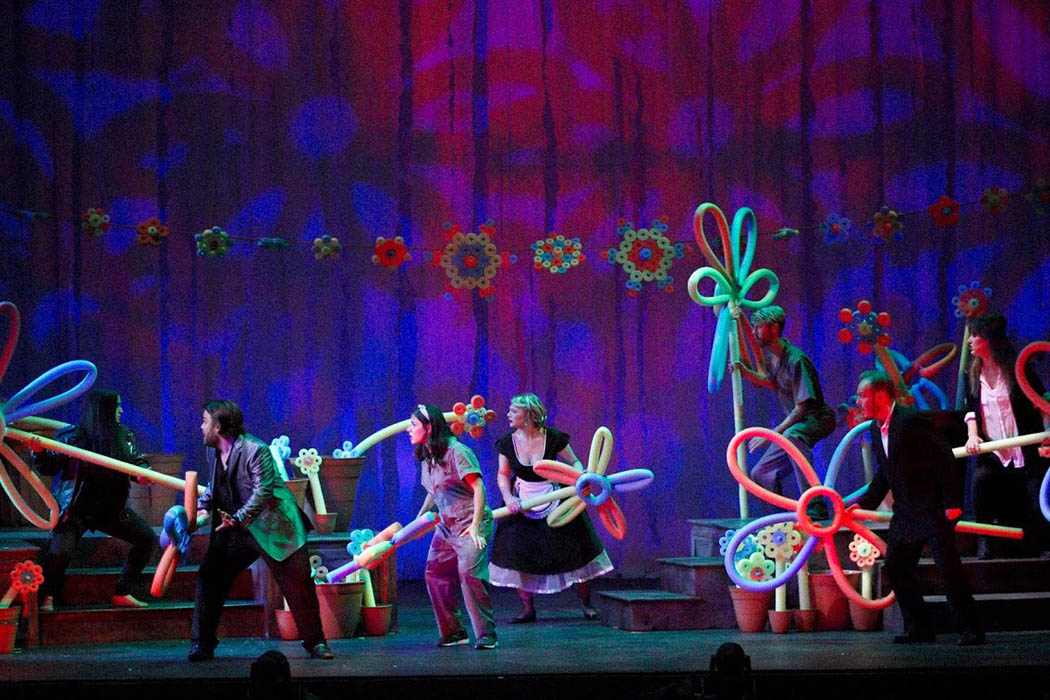Performances reviewed: Friday evening, November 9; Sunday afternoon, November 11
When the opera La finta giardiniera (The Secret Gardener) premiered in Munich in 1775, its composer, Wolfgang Amadeus Mozart, was still two weeks shy of his 19th birthday. We have become so used to tales of Mozart’s historic precociousness, that we often fail to put it in proper perspective—at the time of Finta’s composition, Mozart was several years younger than any of the University of Tennessee Opera Theatre singers who performed in the production of that opera this last weekend.
To be fair, the mature orchestral Mozart was just beginning to reveal himself at the time of Finta, yet his ability to write with vocal color and the rhythm of language in mind seemed to flow from some magical, natural place within his musical being. Mozart also instinctually realized that healthy tempos allowed singers—and the orchestra—opportunity for comic and/or dramatic “sparkle.” Although Mozart’s construction is basically one of arias joined by recitatives, he explores the addition of engaging uptempo ensemble numbers, sequencing that he will eventually perfect in operas like The Marriage of Figaro.
La finta giardiniera’s musical sparkle can almost allow one to ignore the reality that the opera’s libretto is amusingly and unbelievably convoluted, one that strangely vacillates between comedy, mock-seriousness, and violence. That suggested violence comes from the opera’s pre-story involving the aristocratic lovers, Count Belfiore and Violante Onesti, in which he believes he has killed her. Instead, now calling herself Sandrina, she has escaped with her servant Nardo, taking jobs as gardeners for the Podestà (local Mayor). Continuing this tale of hidden identities and mis-matches, Serpetta, the Podestà’s maid, wants to marry her master, yet he is attracted to Sandrina. The Podestà’s neice, Arminda, shows up wanting to marry the Count, although she is pursued by a former lover, Ramiro. In tune with the late 18th Century concepts of class, the couples re-align in the end after angst and grief, but each according to their station in life. Again, this is a social issue that would later be more seriously addressed in The Marriage of Figaro.
In this UTOT production, stage director Scott Skiba has realized the need to keep the singers moving constantly in an environment that holds the audience’s attention with vibrant color and suggestive abstraction. The stage, boxed in with hanging swaths of cloth that take projected images, is otherwise populated with brilliantly colored foam-tubing flowers in a myriad of sizes—objects that become swords, clubs, and almost every other prop required by the action. While this physical staging scheme is unapologetically inventive and fun, it presupposes that the audience, for whatever reason, needs a lot of distracting—a fact that isn’t always helpful to following the plot or recognizing character transformations.

As is the UTOT custom, a double cast was spread over the four performances, one cast taking evening performances, the other the matinees. Taking the role of the Podestà in both casts and making a substantial comic run at physical comedy was Brad Summers.
Singing the role of Sandrina, the “secret gardener,” in the evening cast, was Kathryn Shepas. Her Sandrina was a very sympathetic character, apparently resigned to her situation, yet willing to use force and boldness. This characterization used her voice quality well—agile with crystal clear focus. Her Belfiore was sung by tenor Wayd Odle with a satisfying lyricism that carried the character’s recognition. Emily Johnson was an appropriately haughty Arminda, with an appropriately clear vocal edge that helped define her character. Her pursurer, Ramiro, is a pants role, in this case sporting a leather jacket and comic facial hair, nevertheless sung quite attractively by Sarah Beegle. Beth Stovall gave the maid, Serpetta, a feistiness and worldliness, as well some marvelous arias in which she admits her appeal to men. Logan Campbell’s lanky Nardo was hopelessly in love with Serpetta.

In the matinee cast, Hannah Friend gave her Sandrina a sympathetic and courageous presence as well, and backed it up a spirited characterization rich with confident vocal details. Miles Jenkins gave his Belfiore an amusing sensitivity to go along with his romantic upheaval. Madeline Hamrick took her Arminda toward some delicious sexuality, while her Ramiro, Tori Franklin, gave the role a satisfying presentational life of its own. Anna Young’s Serpetta was a marvelous blend of physical comedy and a strong vocal performance. Her Nardo was sung impressively by Derek Stull.
It was especially satisfying to hear excellently finessed and balanced performances of the Mozart score by the UT Opera Orchestra under the direction of Kevin Class. Class and recitative keyboardist Grace McMullen gave the work a pace and structural rhythm that gave real substance to the unfolding action. One curiosity though—clarinets were substituted for oboes in this production, particularly curious since “flutes and oboes” are mentioned in the libretto. I can only guess at some logistical reason for the substitution.
Kudos, too, go to projection designer Brittany Merenda for the stunning visual environment that, at times, was nothing short of eye candy. Abstraction certainly has a place in an early Mozart comic opera.






